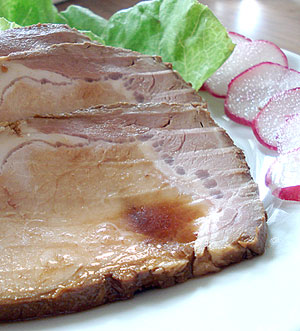
With summer just around the corner, I like to think of food that can be made well ahead and tastes great served cold, or at least cool, to keep me out of a hot kitchen. The vegetable part of this is usually taken care of with seasonal vegetable salads and the like. If the protein part means meat, I like to have pre-cooked pieces tucked away in the freezer.
One of my favorite cold meats is poached and marinated pork, or nibuta. (Ni means to cook in liquid, and buta is pig.) It's very easy to make, stores beautifully in the refrigerator for about a week or much longer in the freezer, and of course, tastes great - savory, slightly sweet, and very juicy. It can be sliced very thinly or julienned for one-dish meal salads or in sandwiches, or chopped up and added to stir-fries, wraps, and so on. It's a great addition to a bento box. It can be cubed or coarsely ground and used instead of char siu (roast pork) in steamed buns or bao. The possibilities are only limited by your imagination.
There's one unusual 'secret ingredient' in the poaching liquid, umeboshi or pickled plum. You can omit this if you like, but adding just one umeboshi seems to de-fat the meat a bit more than just poaching, plus making it taste a bit cleaner and fresher in an interesting way.
Filed under:
basics japanese weekend project summer pork meat
Update: Want to make okonomiyaki from scratch? Try this detailed recipe!
Filed under:
japanese shopping
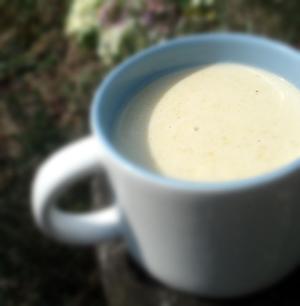
What's the soup of your childhood? The one that your mother made for you when you had a cold, needed cheering up, or just as a treat? For me, there's no question: it's corn cream soup.
Corn cream soup (and yes, it's called like that, not 'cream of corn soup' or 'creamed corn soup') belongs to the _yohshoku_ category of Japanese home cooking. It's an old fashioned, milk based potage, with creamed corn in it. It smells milky, and tastes sweet and savory. It's loved by Japanese kids.
Now, while my mother was a pretty good cook generally, she did have trouble getting some things right. Her curry for instance was always rather watery. And her corn cream soup, instead of being silky smooth, always had little lumps of undissolved roux. I loved those little lumps though - they tasted like tiny dumplings. Later on when I started to make my own corn cream soup I followed recipes, so my corn cream came out smooth and lumpless. That was fine, but I missed the lumps from my childhood memories. So, I incorporated them back.
Everyone uses canned corn to make a corn cream soup. You can be fancy and use fresh, but that lifts this humble soup into the realm of gourmet special-occasion big deal cooking, which is not what my memories are about at all. I have adjusted the usual way of making this soup by using whole corn rather than creamed, since whole corn cans have more actual corn in them and I suspect less added sugar, and I like the mixture of crushed/creamed and whole corn kernels. Besides, creamed corn cans are unheard of here in Switzerland.
Filed under:
japanese soup yohshoku
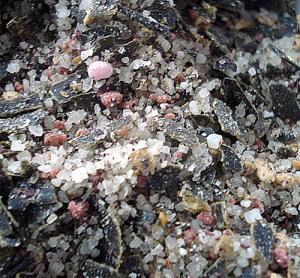
If you browse the aisles of a Japanese grocery, you may run across various instant tsukemono mixes. These come either in liquid or dry form. The dry granules in particular are very handy to have around, and they can make sokuseki zuke in a hurry. However, they usually contain MSG, preservatives and such.
Scouring around the Japanese parts of the interweb, I came across several pages that had recipes for a homemade instant tsukemono mixes, such as this one. They all used MSG or dashi stock granules though, and I wanted to come up with a mixture that was made up 100% of natural ingredients.
After some tinkering around and almost ruining the motor of my food processor, here's the mixture I came up with. To up the umami quotient it has a full 100 grams of finely chopped konbu seaweed in it. It also has some interesting very Japanese ingredients in it such as dried yuzu peel and yukari, dried powdered red shiso leaves.
Filed under:
japanese ingredients vegetarian vegan tsukemono
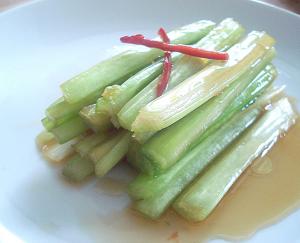
Celery isn't a very Japanese vegetable, but with the addition of the right flavors it can be turned into a refreshingly crunchy pickle that goes well with white rice, which is the base criteria for determining whether a pickle fits a Japanese meal or not. Besides, I always seem to have some celery in my fridge (who doesn't?), and this is a good excuse to use some up.
This is a nice salad-like pickle, that's best eaten with some of the pickling liquid spooned like dressing over the top. There's a nice bite and a color zing from the thin slivers of red chili pepper. (Pirikara means spicy-hot.) There's a little sake and mirin in the dressing, which gives it a twist.
Since celery is more fibrous than cucumber, it needs to marinade for a bit longer. Give it at least 3 hours, or overnight. It doesn't keep too well at room temperature, so reserve this for eating at home. It assembles as quickly as the other quick pickles in this series.
Filed under:
japanese lighter vegetables vegetarian vegan salad tsukemono

Whenever I am feeling blue, one of the foods that I crave is onigiri. You could just chalk that up to the fact that it's mostly rice = carbs and I'm just craving a carb fix. But it really goes beyond that. It's tied to memories of my aunts making row upon row of perfectly shaped onigiri for a family gathering, and the salty tinge on my lips from the giant onigiri my mother made for me for a school outing.
Two of the most popular articles here on Just Hungry are the ones about onigiri. It's great to see so many people from around the world enjoying this quintessential Japanese comfort food.
There are two very interesting Japanese movies where onigiri play a starring role, in quite different ways; Kamome Diner (Kamome Shokudoh) and Supermarket Woman (Suupaa no Onna). Although neither seems to be available on DVD in English speaking countries yet, I thought I'd talk about them a bit.
Filed under:
books and media japanese onigiri memories movies
Seamaiden, who has a lovely gluten-free blog called Book of Yum, asked in the comments here whether Ajinomoto is gluten-free. Since I know that a lot of people become interested in rice-centric Asian cuisines, including Japanese, because of the wide variety of wheat-free dishes, I thought I'd post some of my findings here about Ajinomoto and dashi stock granules rather than bury them in the comments.
Monosodium glutamate or MSG is a concentrated and manufactured form of umami. It is a flavor enhancer with a lot of controversy. I won't get into that at the moment, since reactions to MSG really vary widely depending on the individual. The reality is that MSG is present in many manufactured food products.
Filed under:
japanese ingredients health gluten-free
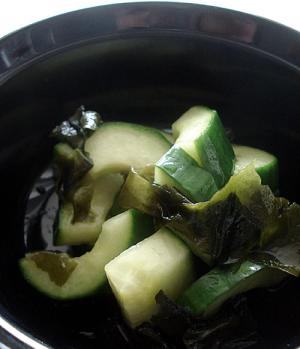
This Japanese sokusekizuke method of letting vegetables marinate in a vinegar-based marinade is similar to Western pickling methods, but there's no canning and sterilation and things involved since these are meant to be eaten within a couple of days like all quick pickles. The vinegar marinade is simply meant to enhance the flavors of the vegetables rather than preserve it for long keeping.
These cucumber pickles are sweet, sour and a bit salty all at the same time. The flavor is quite mild and fresh, so I can eat these several days in a row and not get tired of them. The wakame seaweed can be left out if you prefer, but makes a nice contrast to the cucumber while adding its own umami to the marinade.
The pickles can be eaten anytime from a couple of hours after putting them in the marinade to about 3 days later or so, if you keep it in an airtight container in the refrigerator.
Filed under:
japanese vegetables salad tsukemono
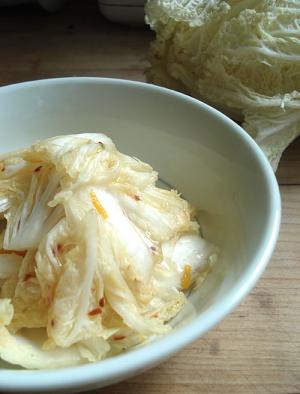
This has to be one of the easiest and tastiest ways of preparing Chinese or napa cabbage (hakusai) that I know of. All you taste is the fresh essence of the cabbage, with the heat of the red pepper and the slight twist of the orange zest.
Did I say easy? Wash and chop up the leaves, mix together the flavoring ingredients, dump all in a plastic bag, shake then massage. That's it. It's ready to eat right away, though the flavors to meld a bit better if you can manage to keep it in the fridge for at least an hour before eating.
I've used ingredients that anyone should have, even if you aren't stocked up on typical Japanese ingredients. Adjust the amount of red pepper flakes up or down to your taste.
Filed under:
japanese lighter vegetables vegetarian quickcook bento vegan under10 tsukemono
In Japan, tsukemono or pickles are used as hashi-yasume, literally "chopstick resters", side dishes that have a totally different texture and flavor. So for instance if you had some grilled meat with a sweet-savory sauce as the main course, you might have some simple, crunchy pickled cucumber slices to go with it.
This week I'll be posting some quick Japanese vegetable pickle recipes. Japanese pickles can be very loosely divided into three kinds: the kind that take some time to 'ripen', but then last indefinitely, rather like Western style pickles; the kind that is ready in a few days, but which require a pickling bed that takes time to make and to maintain; and finally, the quick and easy kind that can be made and eaten within a day. The last two kinds do not keep well - just like fresh vegetables, they must be eaten within a short time.
Quick pickles, called sokusekizuke (instant pickles) or ichiya-zuke (overnight pickles) depending on how long they take to come to full flavor, are very easy to make as their names suggest. They are a great way to prepare vegetables without having to add any additional fat, though a few recipes do call for some oil.
Filed under:
japanese lighter preserves and pickles vegetables vegan salad tsukemono
Pages